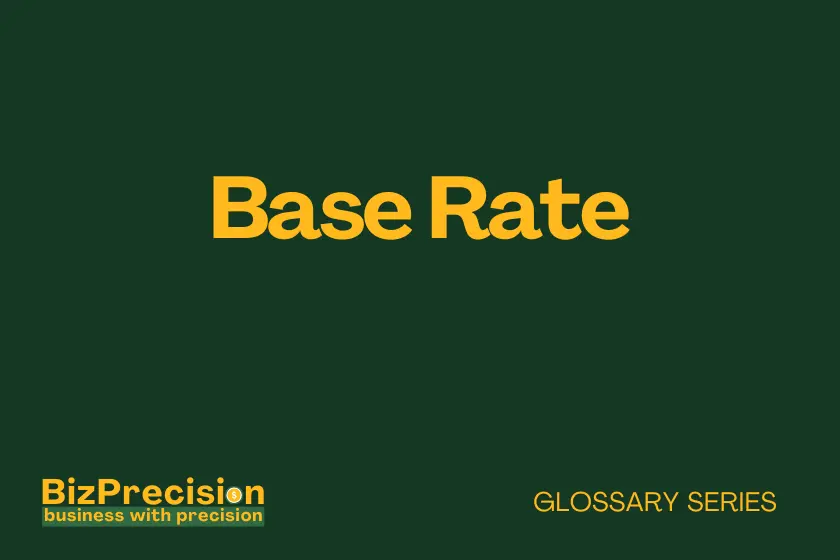What is Base Rate?
Base rate is the foundational interest rate set by central banks that determines the minimum cost of borrowing in a financial system.
The base rate shapes every aspect of lending and borrowing in modern economies. According to the Federal Reserve Economic Data (FRED), changes in base rates influenced over $18.4 trillion in lending activities across U.S. financial markets in 2023. This fundamental rate affects everything from business loans to mortgages.
Let’s explore how base rates work and why they matter for your financial decisions.
Understanding Base Rates in Finance
How Base Rates Work in Banking
Banks use the base rate as their starting point for pricing loans and financial products. When a central bank sets this rate, it creates a floor for borrowing costs. Commercial banks then add their profit margin and risk premiums to this base.
Think of the base rate as the foundation of a building. Everything built on top must start from this level. For example, if the base rate is 3%, a business loan might be priced at base rate plus 2%, making the final rate 5%.
Impact on Commercial Lending
Base rates directly affect how much businesses pay for loans. When rates change, it ripples through the entire lending market. The Bank for International Settlements reports that a 1% rise in base rates typically leads to a 0.7% increase in business lending rates within three months.
This quick transfer of costs means businesses must stay alert to rate changes. A company with a $1 million variable-rate loan would pay $7,000 more annually for each 1% base rate increase.
Relationship with Monetary Policy
Central banks use base rates as their main tool for managing the economy. They adjust rates to control inflation and support economic growth. Higher rates help cool an overheating economy, while lower rates can boost growth during slowdowns.
Recent research from the International Monetary Fund shows that base rate changes take 6-18 months to fully impact the economy. This lag means central banks must plan well ahead when setting rates.
Applications and Implications
Business Lending and Credit
Base rates affect every type of business financing. From short-term loans to long-term bonds, all credit prices start with the base rate. Small businesses feel these effects most strongly since they often rely on variable-rate loans.
A recent Federal Reserve survey found that 68% of small businesses say interest rates significantly impact their operations. When base rates rise, these businesses often need to adjust their growth plans.
Consumer Financial Products
The base rate influences many consumer products. Mortgages, car loans, and credit cards all link to this rate. Banks typically adjust their consumer lending rates within weeks of base rate changes.
For example, on a $300,000 mortgage, a 1% base rate increase means about $190 more in monthly payments. This shows how base rate changes affect household budgets directly.
Economic Growth Effects
Changes in base rates can speed up or slow down economic activity. Lower rates usually encourage borrowing and investment, while higher rates do the opposite. The Congressional Budget Office estimates that a 1% base rate change can alter GDP growth by 0.3% over two years.
Businesses use this information for planning. They might speed up investment plans when rates are low or delay them when rates are expected to rise.
Base Rate Decision-Making
Factors Influencing Base Rates
Central banks consider many factors when setting base rates. They look at inflation, employment, GDP growth, and global economic conditions. Each factor gets careful analysis before any rate change.
Recent data from the World Bank shows that inflation accounts for about 60% of base rate decisions. Employment levels and economic growth split the remaining influence almost equally.
Market Response Mechanisms
Markets react quickly to base rate changes. Bond prices, stock markets, and currency exchange rates all shift when rates move. The Chicago Mercantile Exchange data shows that markets price in expected rate changes months before they happen.
This forward-looking behavior means businesses must watch for rate change signals. Many companies now use financial tools to protect against rate changes.
Risk Assessment and Pricing
Banks use complex models to price loans above the base rate. They add risk premiums based on borrower creditworthiness, loan term, and market conditions. The Federal Reserve’s Senior Loan Officer Survey shows that banks adjust these premiums quarterly.
For example, a top-rated company might pay base rate plus 1%, while a riskier business pays base rate plus 4%. This difference reflects the higher chance of default by riskier borrowers.
Conclusion
Understanding base rates helps you make better financial decisions. Whether you’re running a business or managing personal finances, these rates affect your bottom line. Stay informed about rate changes and plan accordingly.
Take action by:
- Reviewing your loan terms to understand how base rates affect your payments
- Planning major purchases or investments with rate trends in mind
- Building rate changes into your business or personal budget forecasts
Remember, base rates are just one part of the financial picture. Use this knowledge alongside other factors when making important money decisions.







